Published on May 17, 2013
The US-Korea Institute at SAIS is now the newest member of the Fissile Materials Working Group (FMWG). The FMWG has been a forceful presence in support of improved fissile material security and the prevention of nuclear terrorism. The FMWG meets regularly to address issues urgent to the nuclear security agenda and convene the summit of international experts on the sidelines of the Nuclear Security Summit. To find out more about the FMWG, visit http://www.fmwg.org/index.cfm.
Published on March 20, 2012
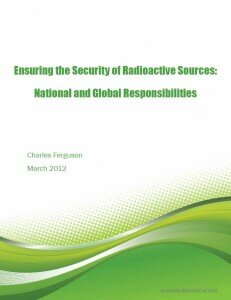 With the 2012 Seoul Nuclear Security Summit just around the corner, the US-Korea Institute at SAIS is proud to announce the release of the full Nuclear Security Summit Working Paper Series. This eight-paper series discusses the history and goals of the Nuclear Security Summit (NSS) process, the progress that has been made since the Washington Summit in 2010, the full range of topics expected to be addressed in the Summit and side events in Seoul, as well as contemplation about the future of the NSS process both in 2014 and beyond.
With the 2012 Seoul Nuclear Security Summit just around the corner, the US-Korea Institute at SAIS is proud to announce the release of the full Nuclear Security Summit Working Paper Series. This eight-paper series discusses the history and goals of the Nuclear Security Summit (NSS) process, the progress that has been made since the Washington Summit in 2010, the full range of topics expected to be addressed in the Summit and side events in Seoul, as well as contemplation about the future of the NSS process both in 2014 and beyond.
For a full listing of papers along with related resources, please visit our NSS papers page.
Published on March 14, 2012
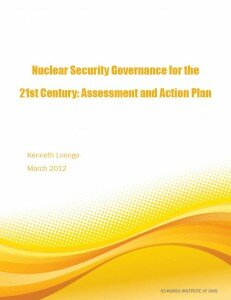 The upcoming Nuclear Security Summit (NSS) in Seoul, South Korea, will raise the international profile of the threat of nuclear terrorism and focus attention on the need to better secure weapons-usable nuclear materials in all corners of the globe. It follows the first NSS held in March 2010 in Washington, DC. Another summit will be held in the Netherlands in 2014. This sequencing of biennial, high-level international political summits has underscored the global importance of addressing the threat of nuclear terrorism. As a result, the NSS has the potential to become the preeminent international forum where the state of global nuclear material security is evaluated and where new commitments are made to improve the world’s defenses against nuclear terrorism. But, to fully realize its potential, the NSS process will need to evolve and participating countries must be willing to accept changes that will strengthen the nuclear material security regime.
The upcoming Nuclear Security Summit (NSS) in Seoul, South Korea, will raise the international profile of the threat of nuclear terrorism and focus attention on the need to better secure weapons-usable nuclear materials in all corners of the globe. It follows the first NSS held in March 2010 in Washington, DC. Another summit will be held in the Netherlands in 2014. This sequencing of biennial, high-level international political summits has underscored the global importance of addressing the threat of nuclear terrorism. As a result, the NSS has the potential to become the preeminent international forum where the state of global nuclear material security is evaluated and where new commitments are made to improve the world’s defenses against nuclear terrorism. But, to fully realize its potential, the NSS process will need to evolve and participating countries must be willing to accept changes that will strengthen the nuclear material security regime.
In this paper, Kenneth Luongo (Partnership for Global Security) outlines the various elements of the current nuclear security regime, and suggests a new and comprehensive architecture that emphasizes demonstrated performance and accountability with clear but flexible standards.
Download “Nuclear Security Governance for the 21st Century: Assessment and Action Plan,” by Kenneth Luongo.
For related papers, visit our Nuclear Security Summit page.
Published on March 5, 2012
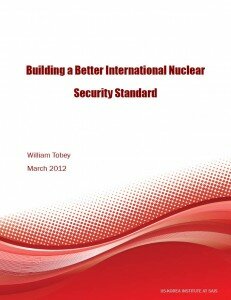 A 1986 National Intelligence Estimate concluded that a small number of groups may have been capable of high-level nuclear terrorism, if they had access to a weapon or sufficient fissile material, but were inhibited by the political consequences.
A 1986 National Intelligence Estimate concluded that a small number of groups may have been capable of high-level nuclear terrorism, if they had access to a weapon or sufficient fissile material, but were inhibited by the political consequences.
Access to fissile material is key—both for terrorists trying to attain a nuclear capability, and those racing to stop them. And global stocks of fissile material—highly enriched uranium and plutonium separated from spent fuel—are roughly 2,000 metric tons and growing. Moreover, this material is spread across dozens of sites, with hundreds of buildings, in 30 some countries, under varying security conditions. Consequently, the security of fissile material is not merely a theoretical concern.
In the latest installment of the USKI Working Paper Series on the Nuclear Security Summit process, William Tobey (Belfer Center, Harvard University) illustrates the very real threat of nuclear terrorism that looms today, which has been the impetus for the Nuclear Security Summit process, and suggests what measures the international community should be taking to ensure a higher standard of security for all nuclear material.
Download “Building a Better International Nuclear Security Standard,” by William Tobey.
For related papers, visit our Nuclear Security Summit page.
Published on March 4, 2012
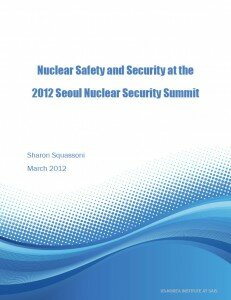 As Seoul prepares to host the 2012 Nuclear Security Summit, the meeting will probably resemble its predecessor in many ways. Three years after President Obama’s Prague speech, nuclear security still offers some of the “lowest hanging fruit” in terms of progress on the nuclear agenda. The context for the 2012 summit, however, is quite different. There is less optimism about progress toward nuclear disarmament, no resolution in sight for the challenges posed by the North Korean and Iranian nuclear weapons programs, and less optimism about peaceful nuclear energy following the devastating accident in March 2011 at the Fukushima Daiichi nuclear power plant in Japan.
As Seoul prepares to host the 2012 Nuclear Security Summit, the meeting will probably resemble its predecessor in many ways. Three years after President Obama’s Prague speech, nuclear security still offers some of the “lowest hanging fruit” in terms of progress on the nuclear agenda. The context for the 2012 summit, however, is quite different. There is less optimism about progress toward nuclear disarmament, no resolution in sight for the challenges posed by the North Korean and Iranian nuclear weapons programs, and less optimism about peaceful nuclear energy following the devastating accident in March 2011 at the Fukushima Daiichi nuclear power plant in Japan.
In this paper, Sharon Squassoni explores the intersections of nuclear safety and nuclear security and how this discussion will likely be addressed at the upcoming 2012 Seoul Nuclear Security Summit.
Download, “Nuclear Safety and Security at the 2012 Seoul Nuclear Security Summit,” by Sharon Squassoni.
Find related papers and resources on our Nuclear Security Summit pages.
Published on March 1, 2012
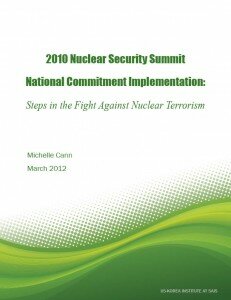 As a complement to the objectives detailed in the 2010 Washington Communiqué and Work Plan, a number of countries made national pledges to take specific measures to improve global nuclear security. These ranged from domestic, unilateral measures to cooperative, multinational contributions that bolster global nuclear security.
As a complement to the objectives detailed in the 2010 Washington Communiqué and Work Plan, a number of countries made national pledges to take specific measures to improve global nuclear security. These ranged from domestic, unilateral measures to cooperative, multinational contributions that bolster global nuclear security.
In advance of the Seoul Summit, this paper provides an overview of the steps that countries have taken to implement their voluntary, national commitments and demonstrates where needs and gaps of intention remain. The information in this report was obtained primarily from open source publications and is accurate as of February 2012.
Download “2010 Nuclear Security Summit National Commitment Implementation: Steps in the Fight Against Nuclear Terrorism,” by Michelle Cann.
For related papers, visit our Nuclear Security Summit page.
Published on February 29, 2012
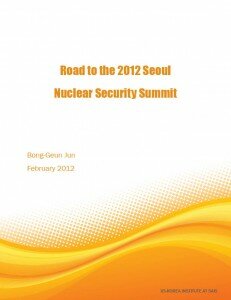 The second Nuclear Security Summit (NSS) will be held in Seoul, South Korea, on March 26-27, 2012. This summit, officially named “The 2012 Seoul Nuclear Security Summit,” will be the largest such meeting held in Korea in modern Korean history, just as the 2010 session was the largest summit ever held in Washington, DC.
The second Nuclear Security Summit (NSS) will be held in Seoul, South Korea, on March 26-27, 2012. This summit, officially named “The 2012 Seoul Nuclear Security Summit,” will be the largest such meeting held in Korea in modern Korean history, just as the 2010 session was the largest summit ever held in Washington, DC.
Dr. Bong-Geun Jun, Director of the Center for Nonproliferation and Nuclear Security at the Institute of Foreign Affairs and National Security (IFANS), discusses South Korean and international efforts to prepare for the 2012 Seoul Nuclear Security Summit and tries to answer key questions about Korea’s role in the NSS process.
Download “Road to the 2012 Seoul Nuclear Security Summit,” by Bong-Geun Jun.
For related presentations and papers, check out our Nuclear Security Summit program page.







